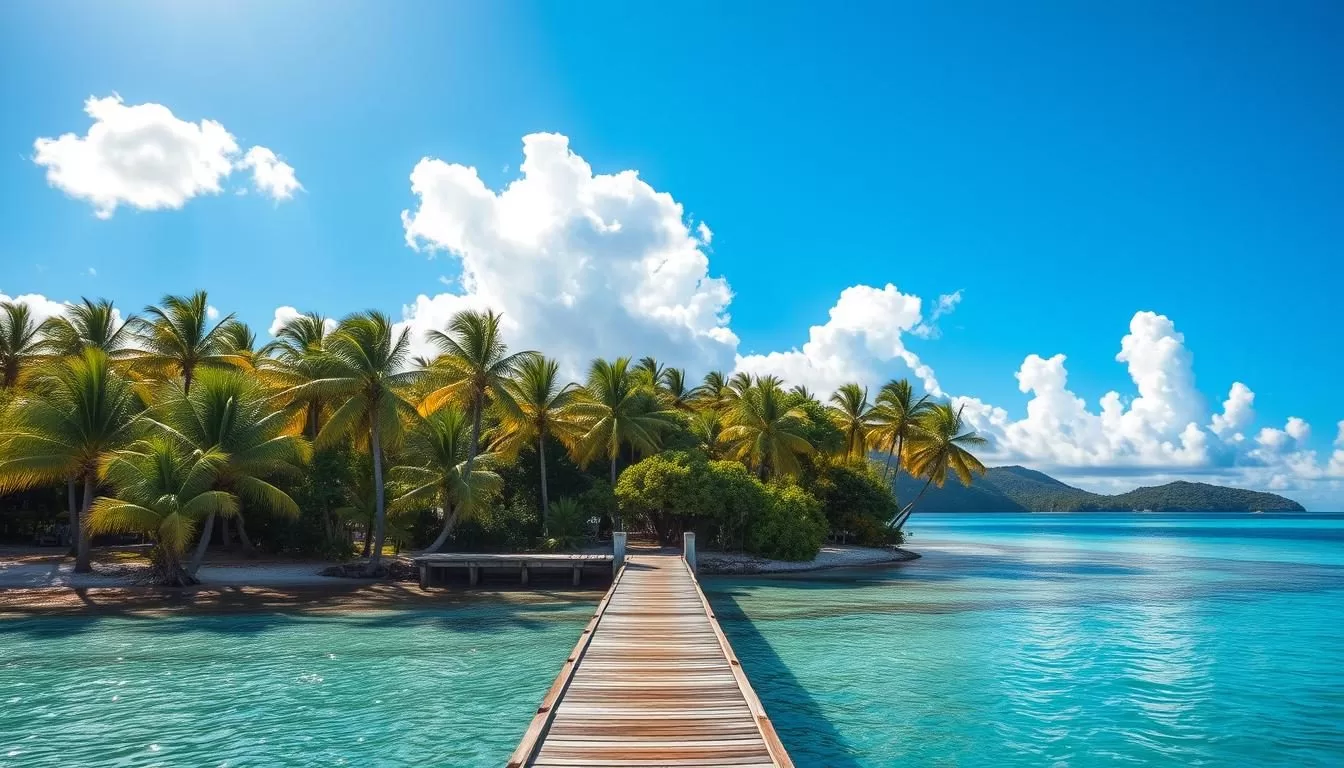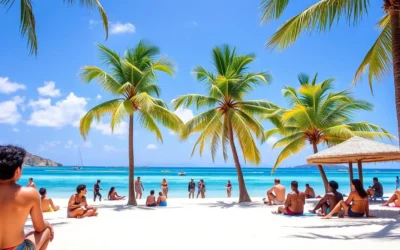✓ Accommodations✓ Flights✓ Rental Cars✓ Tours & Activities
When you’re planning a visit to New Caledonia, understanding the island’s unique tropical climate is crucial. The archipelago enjoys a pleasant tropical climate, with two main seasons that dramatically affect your travel experiences.
The warm and wet season, from November to April, and the cooler dry season, from May to October, influence everything from beach activities to accommodation prices. By understanding these weather patterns, you can align your travel goals with the ideal conditions for your preferred activities.
This guide will walk you through the month-by-month weather patterns, seasonal highlights, and insider tips to plan your perfect trip. Whether you’re a beach lover or a cultural explorer, timing your visit strategically can significantly enhance your experience in this French-influenced tropical paradise.
Understanding New Caledonia’s Tropical Climate
When planning a trip to New Caledonia, understanding its tropical climate is crucial for making the most of your visit. The islands’ climate significantly influences the travel experience, affecting everything from the clarity of waters for snorkeling to the accessibility of hiking trails.
The Two Distinct Seasons
New Caledonia experiences two distinct seasons: the wet season and the dry season. The wet season, which runs from November to April, is characterized by higher humidity and more frequent rainfall. In contrast, the dry season, from May to October, offers more predictable weather patterns, making it easier to plan outdoor activities without disruptions.
The best times to visit New Caledonia for warm-weather activities are from early April to mid-May and from late August to mid-December, based on the tourism score.
| Season | Weather Characteristics | Ideal Activities |
|---|---|---|
| Wet Season (Nov-Apr) | Higher humidity, frequent rainfall | Lush landscapes, vibrant nature |
| Dry Season (May-Oct) | Predictable weather, lower humidity | Snorkeling, diving, hiking |
How Weather Affects Your Travel Experience
The weather in New Caledonia dramatically influences your travel experience. During the wet season, you may need to plan your activities around afternoon rain showers, while the dry season allows for more spontaneous planning. The humidity levels during the wet season can make temperatures feel hotter than they actually are, affecting your comfort during travel.
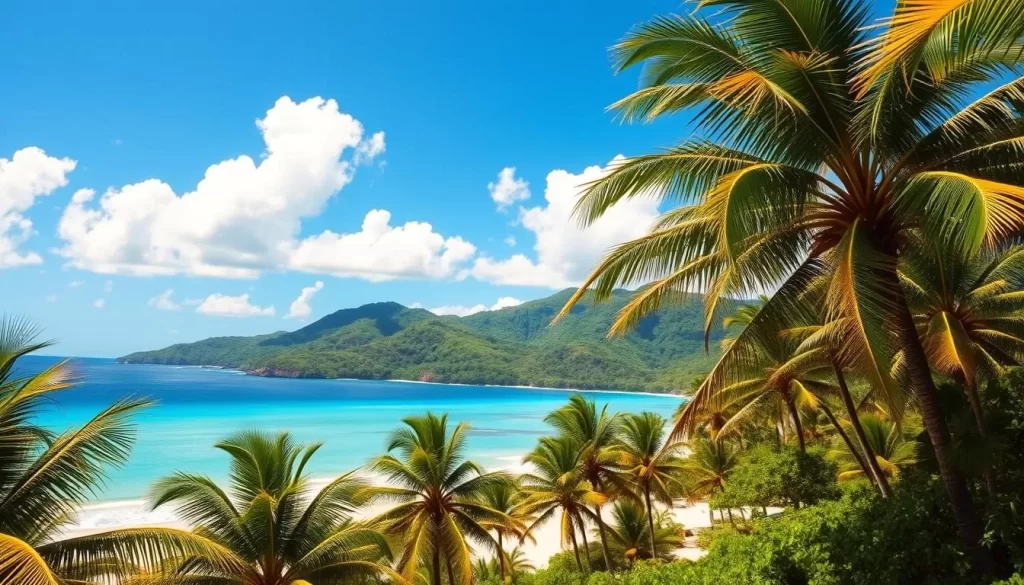
Tourist crowds and accommodation prices are also influenced by the weather patterns, with the dry season seeing higher visitor numbers, especially between July and September. Understanding these patterns can help you plan your visit to New Caledonia during the best time for your preferences, whether you’re looking for fewer crowds or optimal weather for your favorite activities.
The Dry Season: May to October
New Caledonia’s dry season offers a unique blend of pleasant weather and exciting activities. This period, which spans from May to October, is ideal for travelers seeking to enjoy the islands’ beautiful landscapes and outdoor pursuits without the hindrance of rain.
Weather Patterns and What to Expect
During the dry season, New Caledonia experiences its best weather, with minimal rainfall and comfortable temperatures. You can expect average temperatures to range from 18°C to 23°C (64°F to 73°F), making it perfect for outdoor activities like hiking, snorkeling, and exploring the islands.
Advantages of Visiting During the Dry Season
The dry season is considered peak tourist season in New Caledonia, and for good reason. The favorable weather conditions make it an ideal time to enjoy the islands’ natural beauty, from the pristine beaches to the lush forests and mountains. You’ll have the opportunity to engage in various activities, such as snorkeling, diving, and hiking, under optimal conditions.
Some of the key advantages include:
- The dry season coincides with peak tourist season, resulting in higher accommodation prices, especially in popular areas like Nouméa and Isle of Pines.
- You’ll encounter larger crowds at major attractions, beaches, and restaurants, particularly during July and August when many French tourists visit.
- Advance bookings become essential during this peak period, with popular accommodations often filling up months in advance.
Potential Drawbacks to Consider
While the dry season has its advantages, there are also some potential drawbacks to consider when planning your visit to New Caledonia. For instance:
- Some travelers might find the temperatures during June-August slightly cool for swimming, especially in the early mornings and evenings.
- The reduced rainfall means the landscapes aren’t as lush and vibrant as during the wet season, with some waterfalls having reduced flow.
- Prices for activities, tours, and restaurants tend to be higher during these peak months due to increased demand.
By understanding these factors, you can better plan your trip and make the most of your time in New Caledonia during the dry season.
The Wet Season: November to April

As the dry season comes to an end, New Caledonia transitions into its wet season, bringing with it a unique set of weather conditions. You may be wondering what to expect during this period.
Rainfall Patterns and Humidity Levels
During the wet season, New Caledonia experiences significant rainfall, with the most substantial amounts typically occurring between January and March. The increased rain can lead to higher humidity levels, making the atmosphere feel warmer and more tropical.
The rainfall patterns can be quite varied, with some days experiencing heavy downpours, while others remain relatively dry. You should be prepared for these fluctuations in weather.
Benefits of a Wet Season Visit
While the wet season may deter some travelers, it also brings its own advantages. The lush landscapes and greenery that result from the rainfall can be particularly beautiful, making it an excellent time for nature lovers and photographers. You may also find that popular tourist destinations are less crowded during this period.
Additionally, the wet season can be a good time to enjoy indoor activities, such as visiting museums, taking cooking classes, or simply relaxing in your accommodation.
Preparing for Tropical Storms and Cyclones
One of the main concerns during the wet season is the risk of tropical storms and cyclones. These can bring heavy rain and strong winds, potentially disrupting your travel plans. To minimize the impact, it’s essential to stay informed about weather forecasts and be flexible with your itinerary.
You should also consider purchasing travel insurance that covers weather-related disruptions and cancellations. Many resorts and hotels have cyclone procedures in place, so be sure to familiarize yourself with these upon arrival. Packing appropriate rain gear, including waterproof bags for electronics, quick-dry clothing, and sturdy waterproof footwear, will also help you prepare for the wet season.
Month-by-Month Weather Guide for New Caledonia: Best Months for a Weather-Savvy Trip
A month-by-month guide to New Caledonia’s weather will help you plan your trip during the best times for your preferred activities. Understanding the weather patterns is crucial for making the most of your trip.
January to March: Peak Summer and Wet Season
January to March is peak summer in New Caledonia, characterized by high temperatures and significant rainfall. During this period, the weather is typically hot and humid, with temperatures often reaching their highest levels. The wet season is in full swing, with frequent afternoon showers and occasional tropical storms. If you’re planning to visit during this time, be prepared for the wet season conditions.
The cloudiest month, February, sees the sky overcast or mostly cloudy 60% of the time. Despite the rainfall, the landscape remains lush and green, making it a great time for nature lovers.
April to June: Transitional Period
As the wet season transitions towards the dry season, April to June offers a pleasant climate in New Caledonia. The temperatures begin to cool down slightly, and the rainfall decreases, making it a good time for outdoor activities. The transitional period allows for a balance between warm weather and relatively dry conditions.
During this period, you can enjoy various activities without the intense heat or excessive rainfall. It’s an excellent time for water activities like snorkeling and diving, as the sea temperatures are comfortable.
July to September: Winter and Dry Season
July to September marks the dry season in New Caledonia, characterized by cooler temperatures and minimal rainfall. This period is ideal for travelers who prefer milder weather and are looking to avoid the wet season. The dry season is perfect for hiking and exploring the island’s natural beauty.
The dry conditions make it an excellent time for outdoor adventures, with clear skies and comfortable temperatures. You can enjoy activities like biking and sightseeing without the hindrance of rain.
October to December: Spring and Early Summer
October to December is a transitional period leading into the wet season, with temperatures gradually warming up. October is particularly pleasant, with warming temperatures ranging from 64°F to 82°F (18°C to 28°C) and relatively low rainfall. November sees the beginning of the wet season, with more frequent afternoon showers.
By December, the weather is fully transitioning into summer, with temperatures between 70°F and 86°F (21°C to 30°C). The festive holiday celebrations in December add to the charm, making it a great time to experience the local culture.
Best Activities Based on Seasonal Weather
Whether you’re looking for water adventures or land explorations, New Caledonia has something for every season. The diverse climate and rich biodiversity make it an ideal destination for a wide range of activities.
Water Activities: Snorkeling, Diving, and Sailing
New Caledonia’s crystal-clear waters offer excellent conditions for snorkeling and diving, particularly during the dry season when visibility is at its best. With over 1,500 species of fish inhabiting its lagoon, it’s a paradise for marine enthusiasts. Sailing is another popular activity, with calm seas during the dry season making it ideal for exploring the islands.
Snorkeling and diving are best during the dry season (May to October) due to excellent water clarity, allowing you to observe the diverse marine life. Sailing is also more enjoyable during this period due to calmer seas.
Land Adventures: Hiking, Biking, and Exploring
For those who prefer land activities, New Caledonia offers numerous hiking trails, biking paths, and exploration opportunities. The dry season (May to October) is the best time for hiking and biking due to comfortable temperatures and dry conditions. You can explore the islands’ lush forests, mountains, and scenic coastlines.
| Activity | Best Season | Highlights |
|---|---|---|
| Hiking | Dry Season (May-Oct) | Comfortable temperatures, dry conditions |
| Biking | Dry Season (May-Oct) | Scenic routes, less rainfall |
| Exploring | Year-round | Diverse landscapes, cultural sites |
Wildlife Encounters: Whale Watching and Marine Life
New Caledonia is renowned for its wildlife encounters, particularly whale watching. Humpback whales migrate to its waters from July to September, offering a spectacular experience. Other marine life, such as dugongs and marine turtles, can be spotted throughout the year, with the dry season providing better visibility.
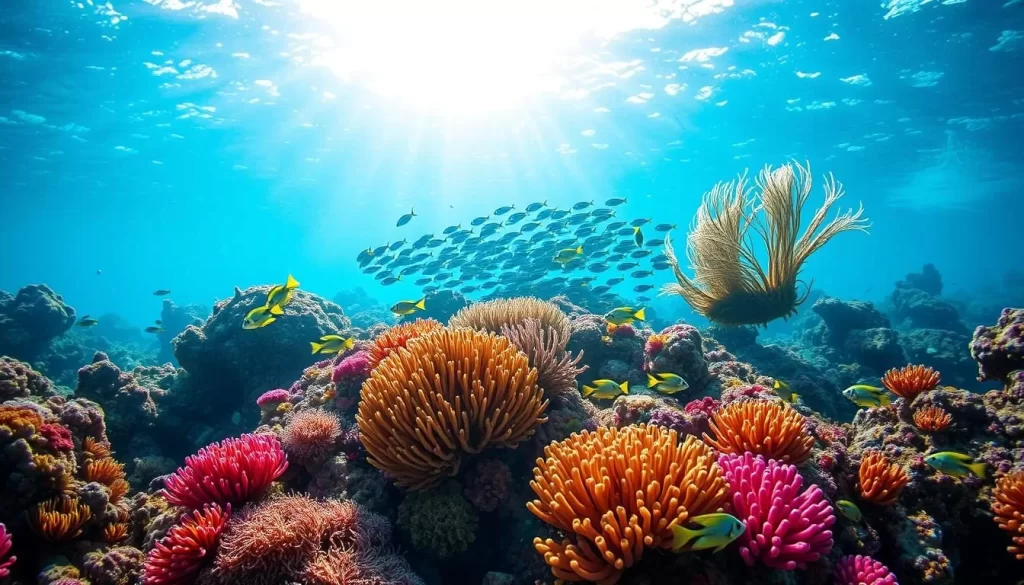
The dry season is ideal for observing diverse reef fish and other marine life due to excellent water visibility. Whale watching is a highlight from July to September, while marine turtle nesting can be observed during the wet season (November to February).
Cultural Events and Festivals Throughout the Year
From festive markets to traditional ceremonies, New Caledonia’s cultural events and festivals are a significant part of the island’s charm. You can experience the unique blend of French and Pacific traditions throughout the year.

Dry Season Celebrations
During the dry season, New Caledonia hosts various cultural events that showcase its rich heritage. You can enjoy the Festival of Music and other celebrations that take place in the capital city, Nouméa. The dry season festivities often feature traditional Kanak dances, local cuisine, and handicraft exhibitions.
The dry season, from May to October, is an excellent time to experience New Caledonia’s cultural events without the hindrance of wet weather. You can participate in the festivities and enjoy the island’s cultural diversity.
Wet Season Festivities
The wet season in New Caledonia is marked by vibrant festivals, including the Carnival de Nouméa in February, which brings colorful parades, music, and dancing to the streets of the capital. You can also experience the Festival of the Yam in March, an important cultural event for the Kanak people.
Despite the rain, the wet season festivities continue with events like the Chinese New Year celebrations and special exhibitions at the Tjibaou Cultural Center. These events provide a unique cultural experience, even on rainy days, and are a great way to explore New Caledonia’s cultural heritage throughout the year.
Weather-Smart Travel Tips for New Caledonia
New Caledonia’s diverse climate means that being prepared is key to a successful trip. Understanding the weather patterns and how they impact your travel plans can make a significant difference in your overall experience.
Packing Essentials for Different Seasons
Packing the right clothing and gear is crucial for a comfortable trip to New Caledonia. During the dry season, lightweight and breathable clothing is recommended, while the wet season calls for waterproof jackets and sturdy footwear. Don’t forget to include essentials like sunscreen, insect repellent, and a hat to protect yourself from the sun.
Accommodation Considerations and Seasonal Pricing
Accommodation options in New Caledonia vary, and prices can fluctuate depending on the season. During the dry season, prices tend to be higher due to increased demand. Consider booking your accommodations in advance to secure the best rates. Some resorts and hotels may offer discounts during the wet season, making it a more budget-friendly time to visit.

Transportation and Accessibility Throughout the Year
Getting around New Caledonia requires some planning, especially when it comes to transportation. Renting a car, particularly a 4WD vehicle, is highly recommended for exploring rural areas, especially during the wet season. Public transportation in Nouméa is reliable, with the Karuia bus network covering major attractions. Domestic flights and ferry services operate year-round, but may be disrupted during the wet season due to weather conditions.
- Renting a car offers flexibility, especially for visiting outer islands and rural areas.
- Public transportation in Nouméa is consistent and affordable.
- Domestic flights and ferry services may face disruptions during the wet season.
Best Months for Different Types of Travelers
Whether you’re a beach lover, a nature enthusiast, or a budget-conscious traveler, New Caledonia has something to offer throughout the year. The best time to visit New Caledonia depends on your priorities and preferences.
For Beach Lovers and Water Sports Enthusiasts
The dry season, from May to October, is ideal for beach lovers and water sports enthusiasts. During this period, the weather is dry and sunny, making it perfect for snorkeling, diving, and sailing. The calm seas and clear waters provide excellent conditions for water activities.
For Hikers and Nature Explorers
For hikers and nature explorers, the shoulder months of April-May and October-November are recommended. The weather is mild, and the landscapes are lush, making it an excellent time to explore New Caledonia’s natural beauty. The reduced rainfall during these months makes hiking trails more accessible.
For Budget-Conscious Travelers
Budget-conscious travelers can take advantage of the discounts offered during the wet season, particularly in February and March. Luxury resorts and boutique hotels often offer rates that are 30-40% below peak season prices. You can enjoy a luxurious stay at a fraction of the cost by visiting New Caledonia during this time.
| Traveler Type | Best Months | Reasons |
|---|---|---|
| Beach Lovers and Water Sports Enthusiasts | May to October | Dry and sunny weather, calm seas |
| Hikers and Nature Explorers | April-May, October-November | Mild weather, lush landscapes |
| Budget-Conscious Travelers | February, March | Discounted rates, luxury at a lower cost |
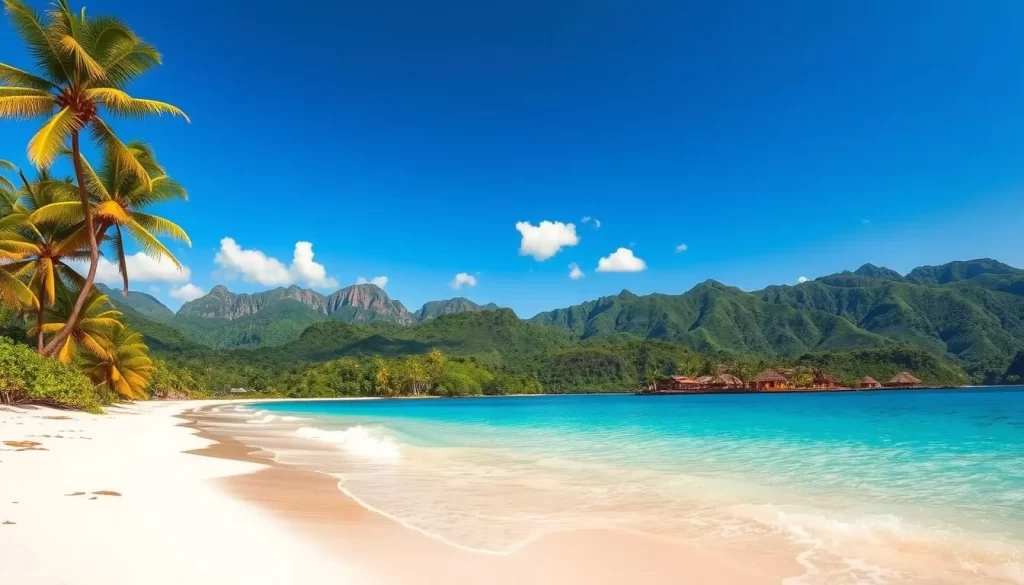
Conclusion: Planning Your Perfect New Caledonia Getaway
The ideal time to visit New Caledonia depends on your priorities – whether you value perfect weather, lower prices, fewer crowds, or specific activities like whale watching or attending the Avocado Festival.
For the best overall experience, consider the shoulder seasons of April-May or September-October, balancing weather, prices, and crowd levels. Aligning your visit with New Caledonia’s seasonal highlights can enhance your experience, whether it’s enjoying tropical fruits at their peak or participating in cultural events.
By planning your trip with seasonal considerations in mind, you’ll maximize your enjoyment of this Pacific paradise. New Caledonia’s unique blend of cultures creates a memorable experience in any season, making it a great time to visit New Caledonia year-round.
The above is subject to change.
Check back often to TRAVEL.COM for the latest travel tips and deals.
